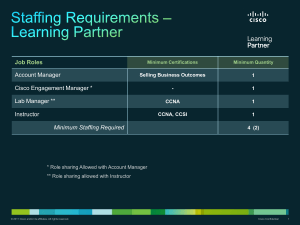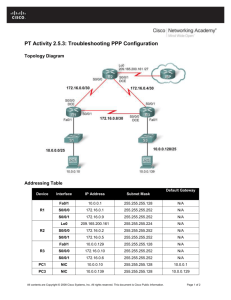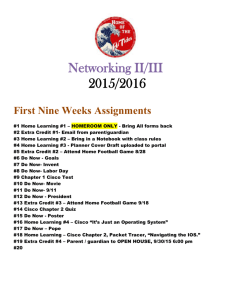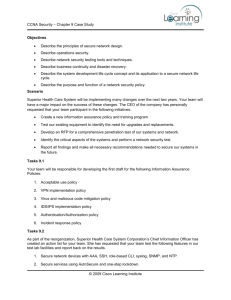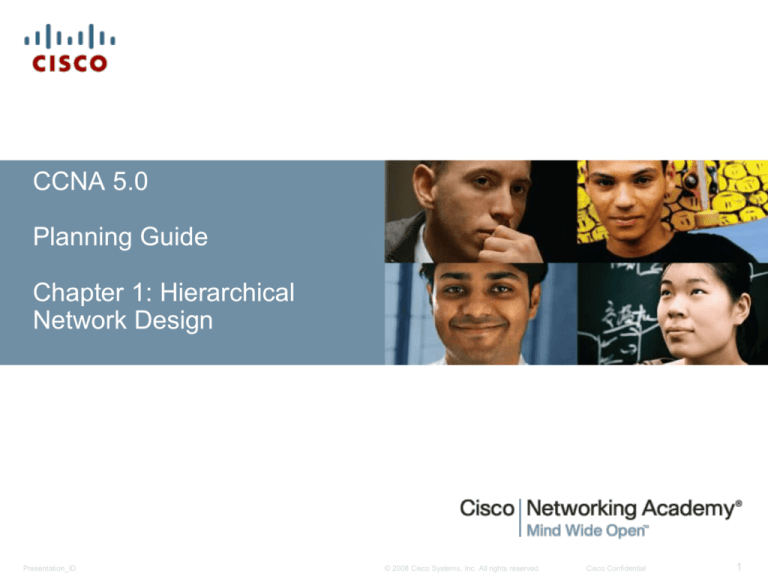
CCNA 5.0
Planning Guide
Chapter 1: Hierarchical
Network Design
Presentation_ID
© 2008 Cisco Systems, Inc. All rights reserved.
Cisco Confidential
1
Chapter 1: Objectives
Describe how a hierarchical network model is used to design
networks.
Explain the structured engineering principles for network design:
Hierarchy, Modularity, Resiliency, Flexibility.
Describe the three layers of a hierarchical network and how they
are used in network design.
Identify the benefits of a hierarchical design.
Describe the Cisco Enterprise Architecture Model.
Describe the three new business network architectures: borderless
network architecture, collaboration network architecture, and the
data center or virtualization network architecture.
Presentation_ID
© 2008 Cisco Systems, Inc. All rights reserved.
Cisco Confidential
2
Chapter 1: Overview
This chapter:
Introduces network design concepts, principles, models, and
architectures
Describes the benefits obtained by using a systematic design
approach
Discusses emerging technology trends that will affect network
evolution
Presentation_ID
© 2008 Cisco Systems, Inc. All rights reserved.
Cisco Confidential
3
Chapter 1: Activities
What activities are associated with this chapter?
1.0.1.2 Class Activity – Design Hierarchy
1.1.2.6 Activity – Identifying Hierarchical Network Characteristics
1.2.1.3 Activity – Identifying Modules in a Network Design
1.2.2.6 Activity – Identify Modules of the Cisco Enterprise Architecture
1.3.2.5 Activity – Identifying Evolving Network Architecture
Terminology
1.4.1.1 Class Activity – Borderless Innovations - Everywhere
1.4.1.2 Packet Tracer – Skills Integration Challenge – OSPF
1.4.1.3 Packet Tracer – Skills Integration Challenge – EIGRP
Presentation_ID
© 2008 Cisco Systems, Inc. All rights reserved.
Cisco Confidential
4
Chapter 1: Packet Tracer Activity Password
The password for all the Packet Tracer activities in this chapter is:
PT_ccna5
Presentation_ID
© 2008 Cisco Systems, Inc. All rights reserved.
Cisco Confidential
5
Chapter 1: Assessment
Students should complete Chapter 1 Exam after completing
Chapter 1.
Worksheets, labs and quizzes can be used to informally assess
student progress.
Presentation_ID
© 2008 Cisco Systems, Inc. All rights reserved.
Cisco Confidential
6
Chapter 1: New Terms
What terms are introduced in this chapter?
1.1.1.1
Cisco CCDA®
1.1.1.2
Hierarchy
Modularity
Resiliency
Flexibility
Access Layer
Distribution Layer
Core Layer
Virtual Access Control Lists (Vacls)
Auxiliary VLANs for VoIP
Access-distribution
Enterprise Edge
Cisco Enterprise Architecture Modules
Enterprise Campus
Enterprise Edge
Service Provider Edge
1.1.2.1
1.1.2.2
1.2.1.2
1.2.2.1
Presentation_ID
© 2008 Cisco Systems, Inc. All rights reserved.
Cisco Confidential
7
Chapter 1: New Terms (cont.)
What terms are introduced in this chapter?
1.2.2.1
1.2.2.3
1.2.2.4
1.2.2.5
1.3.1.1
1.3.1.2
1.3.2.1
Presentation_ID
Enterprise Data Center
Enterprise Branch
Enterprise Teleworker
Demilitarized Zone (DMZ)
Public Switched Telephone Network (PSTN)
Single-homed
Dual-homed
Multihomed
Dual-multihomed
Metro Ethernet (MetroE)
Bring Your Own Device (BYOD)
Cloud Computing
Cisco Borderless Network Architecture
Collaboration Architecture
Data Center/Virtualization Architecture
Cisco AnyConnect
Borderless Network Services
© 2008 Cisco Systems, Inc. All rights reserved.
Cisco Confidential
8
Chapter 1: New Terms (cont.)
What terms are introduced in this chapter?
1.3.2.3
Cisco Unified Management Solutions
Unified Fabric Solutions
Unified Computing Solutions
1.4.1.1
Security – TrustSec
Mobility – Motion
Application Performance – App Velocity
Multimedia Performance – Medianet
Energy Management – EnergyWise
Presentation_ID
© 2008 Cisco Systems, Inc. All rights reserved.
Cisco Confidential
9
Chapter 1: Best Practices
The instructor should:
Make this chapter as hands-on as possible.
Encourage students to do the chapter activities and labs.
Suggest reading The Internet of Everything:
http://www.cisco.com/web/tomorrow-startshere/imagination/index.html
Review Cisco Networking Design solutions:
http://www.cisco.com/en/US/netsol/ns741/networking_solutions_pro
gram_home.html
Presentation_ID
© 2008 Cisco Systems, Inc. All rights reserved.
Cisco Confidential
10
Chapter 1: Additional Help
For additional help with teaching strategies, including lesson plans,
analogies for difficult concepts, and discussion topics, visit the
CCNA Community at http://community.netacad.net/web/ccna/files.
If you have lesson plans or resources that you would like to share,
upload them to the CCNA Community to help other instructors.
Presentation_ID
© 2008 Cisco Systems, Inc. All rights reserved.
Cisco Confidential
11
Chapter 1: Topics Not in ICND2 200-101
This section lists topics covered by this chapter that are NOT listed
in the ICND2 200-101 Blueprint. Those topics are posted at:
http://www.cisco.com/web/learning/exams/list/icnd2b.html
Instructors could skip these sections; however, they should provide
additional information and fundamental concepts to assist the
student with the topic.
NO TOPICS FROM CHAPTER 1 ARE INCLUDED IN THE ICND 2
OBJECTIVES.
Presentation_ID
© 2008 Cisco Systems, Inc. All rights reserved.
Cisco Confidential
12
Presentation_ID
© 2008 Cisco Systems, Inc. All rights reserved.
Cisco Confidential
13
Presentation_ID
© 2008 Cisco Systems, Inc. All rights reserved.
Cisco Confidential
14



